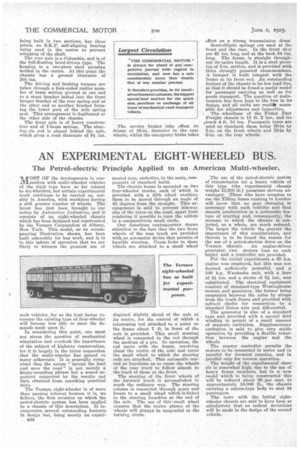AN EXPERIMENTAL EIGHT-WHEELED BUS.
Page 20

If you've noticed an error in this article please click here to report it so we can fix it.
The Petrol-electric Principle Applied to an American Multi-wheeler.
OST OF the developments in con
nection with multi-wheeled vehicles of the rigid type have so far related to six-wheelers, but certain experimental work continues to be carried on, notably in America, with machines having a still greater number of wheels. The latest has just been brought to our notice by Automotive Industries, and it consists of an eight-wheeled chassis which has been designed and constructed by the 'Versare Corporation of Albany, New York. This model, as an accompanying illustration shows, has been built ostensibly for bus work, and it is in this sphere of operation that we are likely to witness the greatest use of such vehicles, for as the load factor increases the existing type of four-wheeler will become Jess able to meet the demands made upon it.'
In considering this point, one must not stress the question of mechanical adaptation and overlook the importance of the subject of highway conservation, for it is largely in the latter connection :that the multi-wheeler has gained so many adherents. It is generally recognized that the axiom "spread the load and save the road" is not merely a happy-sounding phrase but a sound argument supported by the results and data obtained from searching practical testa.
The Versare eight-wheeler is of more than passing interest because it is, we believe, the first occasion on which the petrol-electric system has been applied to a chassis of this description. It incorporates several outstanding features in design but, being merely an experi B36 mental type, embodies, in the main, components of standard build. The chassis frame is mounted on two four-wheeled trucks, each of which is provided with a fifth wheel enabling them to be moved through an angle of 45 degrees from the straight. This arrangement is said to prevent sideway slip of the tyres On the road, apart from rendering it possible to turn the vehicle in a comparatively small circle.
Our American contemporary draws attention to the fact that the two front wheels of the rear truck are provided with an automatic device that permits of knuckle steering. Crosslinks to these 'wheels are attached to a small wheel
disposed slightly ahead of the axle at its centre, for the control of whieh a telescoping rod attached to a point on the frame about 7 ft. in front of the axle is provided. This small steering wheel is connected to the rod through the medium of a pin. In operation, the rod turns with the frame, revolving about the centre of the axle and turns the small wheel to which the steering rods are attached. This automatic control so functions as to cause the wheels of the rear truck to follow almost in the track of those at the front.
The steering of the front wheels of the forward truck is accomplished in much the ordinary way. The steering column is connected through gears and levers to a small wheel which is linked to the steering knuckles at the end of the axle. The use of this small wheel ensures that the centre planes of the wheels will always be tangential to the turning circle. The use of the petrol-electric syatetii of transmission for a heavy vehicle of this type (the experimental chassis weighs 22,850 lb.) possesses obvious advantages: Those who have occasion to use the Tilling buses running in London will know that no gear changing is necessary with such vehicles and that smooth acceleration is a noticeable feature of starting and, consequently, the stresses to which the chassis is subjected, as a whole, are Much reduced. The larger the vehicle the greater the importance of this consideration, and therein. is to be found the reason far the use of a petrol-electric drive on the Versare chassis. An engine-driven generator, two motors (one On each bogie) and a controller are provided.
For the initial experiments a 60 h.p. engine was employed, but this was not deemed sufficiently powerful, and a 100 h.p. Waukesha unit, with a bore of 4i ins, and a stroke of rd ins., was substituted. The electrical equipment consists of standard-type Westinghouse motors and generator, the former being suspended between the axles by straps from the truck frame and provided with splined shafts for connection to a standard Eaton axle and differential.
The generator is also of a standard type and provided with a special field winding to permit of a small amount of separate excitation. Supplementary excitation is said to give very stable operation by providing a flexible reduction between the engine and the wheels.
The master controller permits the motors to be connected in series and in parallel for forward running, and in parallel only for reverse operation.
The weight of the experimental chassis is somewhat high, due to the use of heavy frame members, but in a new model which is being constructed this will' be reduced about 20,...per cent, to approximately 16,000 lb., the chassis carrying a saloon-type body to seat 44 passengers. The tests with the initial eightwheeler chassis are said to have been so satisfactory that no radical deviations will be made in the design of the second vehicle.




























